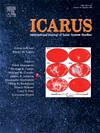利用ATLAS调查数据的小行星相位曲线和相位着色效果
IF 3
2区 物理与天体物理
Q2 ASTRONOMY & ASTROPHYSICS
引用次数: 0
摘要
我们从最新的ATLAS太阳系目录V2 (SSCAT-2)中确定了301,272颗小行星的橙色滤镜和280,953颗小行星的青色滤镜的相位曲线。其中,橙色和青色滤光片中的3345颗和492颗小行星的不确定度分别低于15%。我们的简单模型,只考虑幻影效应,显示出良好的一致性更复杂的方法,需要更少的计算时间。数据库交叉匹配使我们能够根据分类分析G1和G2分布。我们进行了二维Kolmogorov-Smirnov检验来研究两个不同的方面:不同分类群中配对G1、G2分布的相似性和同一分类群内波长依赖性。在比较不同的分类群时,我们无法拒绝11%的橙色样本和31%的青色样本的零假设,这表明橙色过滤器中存在更大的差异。对于波长依赖性,除A类外,G1, G2 (o)与G1, G2 (c)的配对分布在所有配合物中均有统计学差异。我们的分析表明,虽然在相位角低于5°时观察到的相着色行为没有明显的变红或变蓝偏好,但在10°-30°范围内,变红占主导地位。我们还观察到G2的不确定性比G1小。仿真结果表明,在小相角情况下,G2对缺少数据的敏感性较低。这与H, G1, G2函数的定义有关,其中G1更多地贡献于相位曲线的反对效应,G2更多地贡献于相位曲线的线性部分。我们的编目独立算法适用于新的数据集,包括未来的LSST数据。本文章由计算机程序翻译,如有差异,请以英文原文为准。
Asteroid phase curves and phase coloring effect using the ATLAS survey data
We determined phase curves for 301272 asteroids in the orange filter and 280953 in the cyan filter from the latest ATLAS Solar System Catalog V2 (SSCAT-2). Among them, 3345 and 492 asteroids in the orange and cyan filters, respectively, have uncertainties below 15%. Our simple model, which considers only the apparition effect, showed good consistency with more sophisticated methods requiring much less computational time. Database cross-matching allowed us to analyze G1 and G2 distributions according to taxonomy. We conducted two-dimensional Kolmogorov–Smirnov tests to investigate two distinct aspects: similarities in paired G1, G2 distributions across different taxa and wavelength dependency within the same taxa. When comparing different taxa, we could not reject the null hypothesis for 11% of the orange sample and 31% of the cyan sample, indicating more disparities in the orange filter. For wavelength dependency, paired distributions of G1, G2 (o) vs. G1, G2 (c) showed statistically significant differences across all complexes, except for the A class. Our analysis suggests that while phase coloring behaviors are observed without a clear preference for reddening or bluening at phase angles below 5°, reddening predominates in the 10°–30°range. We also observed smaller uncertainties in G2 than in G1. Simulations showed that G2 is less sensitive to lack of data at small phase angles. This is related to the definition of the H, G1, G2 function, where G1 contributes more to the opposition effect and G2 the linear part of the phase curve. Our catalog-independent algorithms are adaptable to new data sets, including future LSST data.
求助全文
通过发布文献求助,成功后即可免费获取论文全文。
去求助
来源期刊

Icarus
地学天文-天文与天体物理
CiteScore
6.30
自引率
18.80%
发文量
356
审稿时长
2-4 weeks
期刊介绍:
Icarus is devoted to the publication of original contributions in the field of Solar System studies. Manuscripts reporting the results of new research - observational, experimental, or theoretical - concerning the astronomy, geology, meteorology, physics, chemistry, biology, and other scientific aspects of our Solar System or extrasolar systems are welcome. The journal generally does not publish papers devoted exclusively to the Sun, the Earth, celestial mechanics, meteoritics, or astrophysics. Icarus does not publish papers that provide "improved" versions of Bode''s law, or other numerical relations, without a sound physical basis. Icarus does not publish meeting announcements or general notices. Reviews, historical papers, and manuscripts describing spacecraft instrumentation may be considered, but only with prior approval of the editor. An entire issue of the journal is occasionally devoted to a single subject, usually arising from a conference on the same topic. The language of publication is English. American or British usage is accepted, but not a mixture of these.
 求助内容:
求助内容: 应助结果提醒方式:
应助结果提醒方式:


